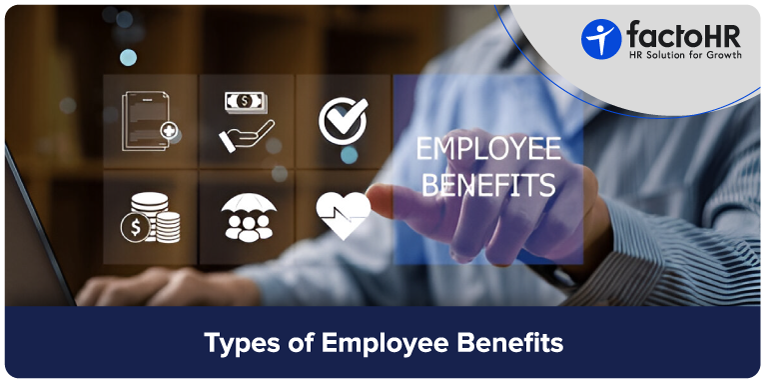Types of Employee Benefits: The Ultimate Guide for HR Managers

Table of Contents
HR managers are aware that candidates evaluate employee benefits as part of a company’s compensation package when searching for a job. Offering competitive employee benefits lays the foundation for a strong and stable workforce. Employee benefits are additional perks and provisions provided for employees beyond their base salary. These may include insurance, paid time off, retirement plans, and wellness programs.
A thorough understanding of the various types of employee benefits is essential for HR professionals to design packages that enhance recruitment, improve retention, and boost employee satisfaction.
In today’s workforce dynamics, organizations are transitioning from traditional employee benefit plans to adopting more holistic, wellness-focused benefits. This shift is redefining modern human resource practices.
In this blog, we will examine the various types of employee benefits and their importance to both employers and employees.

Why are Employee Benefits Important?
With HR benefits, HR managers can build a positive reputation for their company and differentiate themselves in a competitive hiring market. Most organizations provide certain employee benefits by law; however, a well-structured employee benefit plan that resonates with the demands of today’s workforce offers several advantages:
Attracting the Right Talent
Today’s candidates evaluate benefit packages alongside salary before accepting a job offer to assess the overall value of a role. Companies that offer comprehensive and appealing benefits are more likely to attract skilled professionals seeking long-term growth and security.
Improving Retention, Satisfaction, and Loyalty
Employees are more likely to stay with organizations that support their overall well-being. When their needs are met through appropriate benefits, they feel valued and engaged. This stronger connection reflects the benefits of employee engagement, which include improved retention, higher morale, and increased productivity.
Promoting Inclusion in the Workplace
An inclusive benefits package contributes to a respectful and welcoming work environment. Providing options such as parental leave for all genders, flexible holidays, domestic partner coverage, and flexible work hours indicates that your company respects and supports every individual.
Supporting Physical and Financial Well-Being
Providing employees with well-structured benefits that support both physical and financial well-being can reduce absenteeism and enhance motivation. Financial benefits such as health insurance, retirement plans, and financial assistance reduce stress and improve employees’ quality of life. Access to preventive healthcare and wellness programs helps employees prioritize their well-being.
Understanding the Different Types of Employee Benefits in India
In India, employee benefits in HRM include both mandatory (statutory) and voluntary benefits. Many companies are shifting from traditional benefits to offer support that helps employees grow both at work and in their personal lives.
Let’s explore the major types of benefits offered to employees in India:
Health Insurance
This is one of the most common employee benefits offered in India, with many plans extended to employees’ family members. Most companies provide group health insurance plans that include hospital stays, surgeries, and maternity care. Health insurance significantly alleviates financial stress and gives employees a sense of peace of mind.
Retirement Benefits
Apart from mandatory contributions, many employers also offer additional retirement plans or pension schemes to reward employees for their long-term service. Typical schemes that employees use to secure their post-retirement future include the Employees’ Provident Fund (EPF), National Pension Scheme (NPS), and Gratuity.
Paid Time Off (PTO)
Paid time off reduces stress and assists employees in maintaining a healthy work-life balance. It allows employees to take time off from work for personal or medical reasons while still receiving their regular pay. It includes vacation leave, sick leave, casual leave, and paid holidays.
Flexible Work Arrangements
Preference for flexible work arrangements has become increasingly popular since the COVID-19 pandemic. Many companies are now adopting options like remote or hybrid work, compressed workweeks, and flexible start and end times to support employee satisfaction.
Performance-Based Bonuses
Offering bonuses as financial rewards to employees for their performance has proven to be a reliable method over the years for recognizing hard work. Companies can boost their employees’ morale and encourage productivity. In India, they are often paid during festive seasons, such as Diwali, or at the end of the financial year.
Workplace Wellness Programs
Wellness has a strong connection to employee satisfaction. Workplace wellness programs are initiatives designed to support the physical, mental, and emotional well-being of employees. Modern employee benefits administration includes providing yoga sessions, gym memberships, counseling services, and stress management workshops.
Training and Development
Training and development are integral to core HR strategies for building a skilled and motivated workforce. To foster long-term employee engagement, many companies now provide online courses, certifications, workshops, and internal training programs.
Employee Stock Ownership Plans (ESOPs)
Under this plan, employers offer their employees company stock at little or no additional cost, which they can encash after a specific period at a predetermined price. This sense of ownership often leads to commitment, loyalty, and helps retain top-performing talent.
ESOPs are especially popular in startups, as they give employees a stake in the company. Employees can benefit from the company’s growth and build personal wealth.
Childcare and Parental Support
In today’s scenario, many individuals live in nuclear families, where both partners are often working. In such cases, many companies now offer on-site childcare facilities, flexible parental leave policies, and even educational allowances for their employees’ children. With these benefits, employees can balance both family and career responsibilities.
Commuter Benefits
Daily travel is a hassle for many employees, especially in metro cities, where they often face long and tiring commutes. To make daily travel more convenient for employees, many companies offer shuttle services, fuel reimbursements, or subsidized public transport passes. By easing travel stress, organizations help employees arrive at work with more energy and focus.
Meal Benefits
Meal benefits, such as food cards, cafeteria coupons, or free meals during shifts, reduce an employee’s daily expenses. These provide employees access to nutritious food during work hours, helping them stay focused and energized.
Financial Wellness Benefits
Many companies offer interest-free loans, salary advances, and budgeting support to their workforce. Employees can manage their finances efficiently, particularly during emergencies or times of uncertainty, with the help of these benefits.

Employee Benefits Mandated by Indian Labor Laws
Indian labor laws require every employer to provide certain benefits to employees that protect their rights and well-being.
Employees’ Provident Fund (EPF)
The Employees’ Provident Fund (EPF) is a savings scheme in which both the employer and employee contribute a portion of their monthly salary. This amount helps employees save for retirement.
Employees’ State Insurance (ESI)
Employees’ State Insurance (ESI) is a medical benefit scheme for employees earning below a
specific salary limit. It covers expenses related to illness, maternity, and even injuries or death caused by work-related incidents.
Gratuity
Gratuity is a one-time payment made to employees upon their departure from the company, typically after they have served for at least five consecutive years. It’s a reward for their loyalty and dedicated service.
Maternity Leave
Maternity leave is a legal right under the Maternity Benefit Act. Women employees are entitled to paid maternity leave of up to 26 weeks if they have fewer than two surviving children. Those with two or more children are eligible for 12 weeks of paid leave.
Paid Leave
Paid leave is another mandatory benefit. This includes earned leave for vacations, sick leave for health issues, and casual leave for urgent or personal needs. National holidays are also covered in paid leave.
Minimum Wages
Minimum wages are legally mandated, and employers are required to pay at least the specified amount, which differs based on the nature of the work and the geographic location. This regulation ensures that all employees receive fair and just compensation for their efforts.
Overtime Pay
Overtime pay is also a statutory entitlement. When employees work beyond standard working hours, Indian labor law mandates that they must be compensated at twice their regular hourly rate for those additional hours.
Conclusion
Today’s employees seek more than just a monthly paycheck. They expect a well-rounded blend of traditional financial stability and modern, flexible benefits that support both their personal and professional lives.
A strong employee benefits program is no longer just an HR formality. It is a necessity for enhancing employee satisfaction and fostering a strong company culture.
When designed thoughtfully, employee benefits help organizations reduce employee benefit expenses, enhance employee retention, and increase employee engagement.
As an HR manager, staying informed and proactive in benefits planning is crucial for driving long-term success. Partnering with platforms like factoHR can ease most of your HR management responsibilities, including providing your employees with appropriate types of employee benefits. From statutory benefits to wellness programs and modern perks, factoHR offers all-in-one HR solutions that simplify and enhance the impact of benefits administration.

FAQs
What are Employee Benefits?
Employee benefits are non-wage compensation provided by employers, including insurance, paid leave, bonuses, and other forms of compensation.
What are the Top Benefits Employees Want?
Health insurance, flexible work arrangements, retirement benefits, paid time off, wellness programs, and opportunities for career development are among the top benefits that employees seek.
Do Employee Benefits Matter?
Employee benefits are crucial in today’s competitive work environment, as they significantly impact employee satisfaction, productivity, and loyalty. Good benefits improve recruitment and retention.
What are the Standard Employee Benefits in India?
Health insurance, EPF, ESI, gratuity, maternity leave, paid holidays, and overtime pay are the standard employee benefits in India.
What are Employee Benefits in HRM?
In Human Resource Management (HRM), employee benefits refer to a comprehensive set of non-wage compensations provided by an employer to employees, in addition to their regular salaries. These benefits are strategically designed to enhance employee well-being, improve job satisfaction, and promote higher levels of engagement and productivity.
What are the 4 Major Categories of Employee Benefits?
The four main categories of employee benefits include health-related benefits, financial benefits, work-life balance benefits, and developmental or educational benefits.
Grow your business with factoHR today
Focus on the significant decision-making tasks, transfer all your common repetitive HR tasks to factoHR and see the things falling into their place.

© 2025 Copyright factoHR


